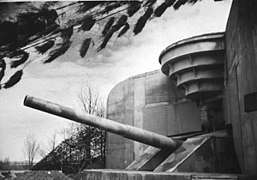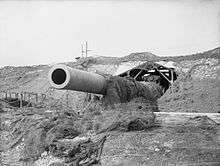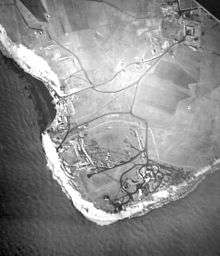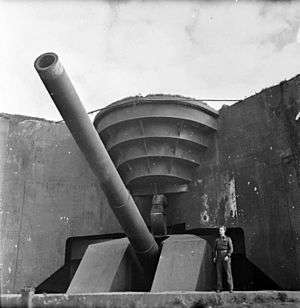Operation Undergo
Operation Undergo was an attack by the 3rd Canadian Infantry Division on the German garrison and fortifications of the French port of Calais during September 1944. A subsidiary operation was executed to capture German long-range, heavy artillery at Cap Gris Nez, which threatened the sea approaches to Boulogne. The operation was part of the Clearing the Channel Coast by the First Canadian Army, following the victory of Operation Overlord and the break-out from Normandy. The assault on Calais followed the formula used at Boulogne: seal off the town, soften up the defenders with artillery, aerial and naval bombardments and infantry assaults supported by armour, including flame-throwing tanks and coordinated creeping artillery barrages.
Although the city had been declared a fortress (Festung) when pressed, its second-rate garrison needed little persuasion to surrender. This reluctance to fight to the end was repeated at Cap Gris Nez. The 7th and 8th Canadian Infantry Brigades started the main attack from south-west of Calais and cleared the outer defences on the southern and western sides of the port. The 8th Brigade were then transferred to the eastern side and the inner defensive lines were attacked from both sides. The Germans called for a truce which, after some misunderstanding, lead to an unconditional surrender of the garrison. In the meantime, the 9th Brigade took the heavy batteries on Cap Gris Nez.
Background
Allied break-out
Across northern France, the German army was in headlong retreat after their military disaster at Falaise and the allied break-out. There were no reserve defences to fall back on, as Hitler had forbidden their construction. The rapid allied advances into eastern France and across Belgium, however, had stretched the allied supply lines and the acquisition of new ports through which to import materiel was a priority for the First Canadian Army.
Bernard Montgomery had assessed that he needed the Channel ports of Le Havre, Dieppe, Boulogne, Calais and Dunkirk to supply his 21st Army Group and he repeatedly pressed the Canadian army commander, Henry Crerar, to capture these ports. Most of them had been designated as "Fortresses", to be fortified and held by their garrisons for as long as was possible. The garrison troops, however, were not first class. The Calais commander, Oberstleutnant Ludwig Schroeder, commented that his garrison was "mere rubbish", consisting of 7500 sailors, airmen and soldiers of whom only 2500 were available for use as infantry. Morale of the isolated troops was low, they were susceptible to Allied propaganda; many were "Volksdeutsche" (ethnic Germans born in foreign countries), and "Hiwis" (foreign volunteers). A report of the post battle interrogations of prisoners described the garrison thus: "Army personnel were old, ill, and lacked both the will to fight and to resist interrogation; naval personnel were old and were not adjusted to land warfare; only the air force A.A. gunners showed any sign of good morale-and were also the only youthful element of the whole garrison." On the other hand, after his capture Schroeder was assessed by his interrogators as a "mediocre and accidental" leader, who only became commander of the area because he happened to be present.[1][2] An essential objective was to silence the German heavy coastal batteries at Cap Gris Nez, Cap Blanc Nez and Calais which could threaten Boulogne bound shipping and bombard Dover and inland targets.[3]
Terrain

The French coast goes northwards from Boulogne and turns sharply at Cap Gris Nez to a line roughly south to north-east. This alignment continues to beyond the Belgian border. There are no large natural harbours, but important docks have been formed in the low-lying land at Calais. While the landscape around Cap Gris Nez and neighbouring Cap Blanc Nez is a continuation of the rolling rural Boulonnais hills, Calais itself sits at the coastal edge of a low flat plain drained by the River Aa and manmade watercourses. Over centuries, the city itself has acquired significant fortifications that, in June 1940, had helped the British in their desperate defence and which had been added to by the Germans as part of the Atlantic Wall and Calais' status as a "fortress".[4] In 1944 the Germans had 42 heavy guns in the vicinity of Calais, including five batteries of cross-channel guns. These were, from the south, Battery "Lindemann" (four 406 mm guns at Sangatte), Battery "Wissant" (150 mm guns near Wissant), Batterie Todt (four 380 mm guns), "Grosser Kurfurst" (four 280 mm guns) and "Gris Nez" (three 170 mm guns).[5] The Germans had broken the drainage systems, causing much of the surrounding area to flood. To this they had added large barbed wire entanglements, minefields and blockhouses.[4]
Prelude
Spry's plans would follow the successful precedent set at the Siege of Boulogne (Operation Wellhit) earlier in September: a general bombardment from land, sea and air to "soften up" the defenders, if not actual destruction of the defences. Infantry assaults would follow, preceded by local bombardments to keep defenders from their posts until too late to be effective and accompanied by flame-throwing armoured vehicles (Crocodiles and Wasps) to act as final "persuaders". Kangaroo personnel carriers would be used to deliver infantry as close to their objectives as possible.
The assaults were planned to approach Calais from the west and south-west, avoiding the worst inundations and the main urban areas. The 8th Brigade's western attack was against the positions at Escalles, near Cape Blanc Nez, and Noires Mottes. The 7th Brigade was to assault the garrisons of Belle Vue, Coquelles and Calais itself. The eastern side of the city was screened by The Cameron Highlanders of Ottawa to prevent a break-out. Meanwhile, the 9th Brigade would take over from the 7th Reconnaissance Regiment at Cape Gris Nez and prepare to capture the batteries there.
Montgomery had been directed to bring Antwerp into operation and, in turn, he pressed Crerar. Crerar recognised the considerable effort being used to capture the ports and the time needed to bring the ports back into use. Having obtained the Royal Navy's views he decided that he was prepared to accept the "masking" (i.e., isolating the enemy garrison with a reduced force) of Calais and redeployment of the troops and materiel thus freed to assist the opening of Antwerp, a more significant port. This was not passed on to Spry, who continued with the assault on Calais.[6]
Battle
Wissant
The Canadian 7th Brigade had sealed off Calais since early September. An early move by the Regina Rifles captured the coastal town of Wissant, thus isolating the Cap Gris Nez batteries from Calais and capturing Batterie Wissant with its four 150mm guns. This success prompted Spry to attempt to capture Cap Gris Nez. The defences were, however, too much for the two battalions available and the area was left for a major assault later.[4]
Calais
The 7th and 8th Canadian Infantry Brigades opened their attack on Calais and its western coastal defences at 10:15 a.m. on 25 September after a day's delay, following preparatory air and artillery bombardments.[7] The Régiment de la Chaudière were to advance through Escalles, taking Cap Blanc Nez, and link up near Sangatte with the North Shore Regiment. The North Shores had the difficult task of taking Noires Mottes, high ground near Sangatte that had been heavily fortified and where Battery Lindemann was located. To shield Canadian activity around Cap Blanc Nez and Calais from observation and interference from the batteries at Cap Gris Nez, a large smoke screen was established along a 3 km (1.9 mi) line inland from Wissant for five days.[8] The capture of Cap Blanc Nez proved to be unexpectedly easy. As soon as the Chaudieres' assault reached the first defences, the surrender of the whole Cap Blanc Nez was offered. This was completed just two hours later, most defenders reportedly being dead drunk.[4][7]
The North Shores' attack on Noires Mottes was supported by flail tanks from the 79th Armoured Division and gunfire from the 10th Armoured Regiment on the approach through minefields and by Crocodiles to reduce fortifications. Early attempts by small groups of Germans to surrender were discouraged when they were shot down by their own side.[9] The advance was held up, however, by a combination of effective defence and bomb craters that prevented the Crocodiles' advance before nightfall. Negotiations were opened with the help of German prisoners and the Noires Mottes garrison surrendered at first light on the following morning, 26 September. A formidable defensive position and nearly 300 prisoners had been captured cheaply.[10] It appears that the Sangatte battery was also surrendered at the same time.[7] Examination of the forts showed that they had been heavily booby-trapped.[9]
The early successes of 8th Brigade had captured ground that overlooked the 7th Brigade's attack, which greatly helped the Brigade's attacks on the Belle Vue ridge and Coquelles. The 1st Canadian Scottish and the Regina Rifles and The Royal Montreal Regiment were to attack through the Belle Vue fortifications to the seafront just east of Sangatte. At first, following promptly after the artillery barrage, the Canadians overran the first defences. Much, however, had been missed by a truncated bombardment and the Reginas suffered heavy casualties until the reserves, the Canadian Scots, and flame-throwing Crocodiles tipped the balance. The 8th Brigade reached Sangatte on the morning of 26 September.[10] The 8th Brigade's tasks on the western side of Calais were now complete, so it was transferred to the eastern side. There it would relieve the Camerons and apply renewed pressure from another direction.[11]

The next stages would be 7th Brigade's advance through Coquelles and flooded ground to Fort Nieulay and a direct attack on Calais, by the Regina Rifles, following a railway by boat across more flooded ground to the south-west of the city's factory area. These advances were difficult, the defenders held their ground and had to be extracted piecemeal and with care. The Canadian Scots were ordered, in a night attack along the coast to Fort Lapin. On the 27th, the Canadians withdrew temporarily during an attack by heavy bombers on German strongpoints. Despite this, Fort Lapin was only taken after further air attacks and support from tanks and flame tanks. In the meantime, the Winnipegs, again assisted by flame tanks, captured Fort Nieulay and the Reginas had reached their immediate target, the factory district.[12]
Further advances were made by the 7th Brigade on the 28th, but two companies of the Canadian Scots, having crossed the canal protecting Calais' western side, were isolated by heavy enemy fire and were unable to advance or withdraw and nor could they be reinforced or resupplied, until the subsequent truce. Plans were in hand for further crossings into the city when the German commander, Schroeder, requested that Calais be declared an open city. This was rejected as being a delaying tactic but a truce was agreed on 29 September, to allow the safe evacuation of 20,000 civilians from the city.[12] They were carried part way in German lorries and transferred to Canadian transport: in several instances, German drivers declined to return and surrendered on the spot.[1] In the meantime, detailed plans were laid for a strong attack on Calais as soon as the truce ended. These included extensive air attacks.[13]
The truce ended at midday on 30 September and the Canadians resumed battle immediately. This was despite German efforts to effect an immediate surrender – Crerar said that "the Hun, if they wished to quit, could march out with their hands up, without arms, and flying white flags in the normal manner." Schroeder had in fact ordered his men to lay down their arms and the 7th Brigade, entering from the west, encountered no opposition as German troops surrendered to them everywhere. It required a Canadian officer, Lt Colonel Klaehn (C.O. of the Cameron Highlanders), at some personal risk, to enter Calais during an artillery bombardment to accept the formal surrender. Schroeder left Calais at 7:00 p.m. and went into captivity.[14]
Cap Gris Nez

The first attempt, by elements of 7th Brigade, to take Cap Gris Nez on 16–17 September had come to nothing. The 7th Brigade was redeployed for its role at Calais and it was replaced by the 7th Reconnaissance Regiment until a stronger force was available.[15] The 9th Brigade, with armoured support from the 1st Hussars (6th Armoured Regiment) and flail tanks, Churchill Crocodiles and AVREs from the 79th Armoured Division, was deployed to Cap Gris Nez to take the three remaining heavy batteries. On the right, The Highland Light Infantry of Canada (HLI) would attack the two northern batteries, the Grosser Kürfurst (sited on the cape) and Gris Nez (sited at Floringzelle, about 1.25 km (0.78 mi) south-east of Gris Nez); while, on the left, The North Nova Scotia Highlanders (NNS) faced Batterie Todt at Haringzelles, 2 km (1.2 mi) south of Batterie Grosser Kürfurst at Floringzelle. The batteries were protected to landward by extensive defences consisting of minefields, barbed wire, reinforced blockhouses and anti-tank positions.[16]
The infantry attacks were preceded, on the 26 and 28 September, by heavy air raids by RAF Bomber Command.[17] Although these probably weakened the defences as well as the defenders' will to fight, the resultant cratering of the ground impeded the use of armour, tanks becoming stuck in bomb craters.[1] Accurate shooting by Winnie and Pooh, British heavy guns at Dover, disabled Batterie Grosser Kürfurst.[18] The battery had fired inland and caused some casualties among the British artillery assembled inland of Wissant, despite the smokescreen.[19]
On 29 September, artillery opened fire at 6:35 a.m. and the infantry attack began after ten minutes minutes later behind a creeping barrage that suppressed the defenders. The German positions were readily surrendered once the attackers were among them. The HLI had captured Grosser Kurfurst by 10:30 a.m., fewer than three hours from H-Hour and Gris Nez was taken during the afternoon. If anything, the NNS encountered even less resistance, reaching the gunhouses without opposition. The concrete walls were impervious even to AVRE petards but their noise and concussion, along with hand grenades thrown into embrasures induced the German gunners to surrender by mid-morning. The NNS continued on to capture the local German headquarters at Cran-aux-Oeufs.[17] Despite the impressive German fortifications, the defenders had not chosen to continue a hopeless struggle "to the last man" and the operation was concluded at relatively low cost in casualties.[18][20]
Aftermath
The damage to the port was severe and the facilities were not available until November, after Antwerp had been opened. Even then, traffic was limited to personnel.[16] The reduction of the German heavy coastal batteries allowed use of Boulogne: mine-sweeping commenced within hours of the 9th Brigade's success. Dover was finally freed from bombardment and the mayor was sent a German flag from the batteries to mark the event.[20]
The Canadians were subjected to criticism (fairly or otherwise) for their performance at Calais and the other Channel ports; their progress was compared unfavourably with that of other Allied units. Montgomery commented that the Canadian Army had been "badly handled and very slow". Montgomery's perception of the Army commander, Crerar, was poor and there has been speculation that Crerar's departure on sick leave was a convenient diplomatic smokescreen for his removal from command. His replacement, the energetic Guy Simonds, was much preferred by Montgomery and Simonds commanded the forces that cleared the approaches to Antwerp.[21]
The commander of 84 Group, RAF, Air Vice Marshal Leslie Brown, displeased Air Marshal Sir Arthur Coningham by his close co-operation with the Canadian Army. Coningham wished to see the air force act independently, not in close co-operation with the army and looked for "someone less subservient to the army". Once Antwerp had been opened, he appointed Air-Vice Marshal Edmund Hudleston to replace Brown.[22]
Orders of battle
Allied
- Canadian 3rd Infantry Division (All data from Monahan, Appendix C (1947) unless specified.)[23]
- 7th Reconnaissance Regiment (17th Duke of York's Royal Canadian Hussars)
- The Cameron Highlanders of Ottawa (machine gun)
- 7th Medium Regiment, Royal Canadian Artillery
- 12th Field Artillery Regiment, Royal Canadian Artillery
- 13th Field Artillery Regiment, Royal Canadian Artillery
- 14th Field Artillery Regiment, Royal Canadian Artillery
- 3rd Anti-tank Regiment
- 4th Light Anti-aircraft Regiment
- 16th Field Company
- 3rd Canadian Divisional Signals, Royal Canadian Corps of Signals
- No. 3 Defense and Employment Platoon (Lorne Scots)
- "C" Flight, 660 Air Observation Post Squadron, RAF
- 7th Canadian Infantry Brigade
- The Royal Winnipeg Rifles
- The Regina Rifle Regiment, less 1 company
- 1 company, Royal Montreal Regiment[10]
- 1st Battalion The Canadian Scottish Regiment
- 7 Canadian Infantry Brigade Ground Defence Platoon (Lorne Scots)
- 8th Canadian Infantry Brigade
- The Queen's Own Rifles of Canada
- Le Régiment de la Chaudière
- North Shore Regiment
- 8 Canadian Infantry Brigade Ground Defence Platoon (Lorne Scots)
- 9th Canadian Infantry Brigade
- The Highland Light Infantry of Canada
- The Stormont, Dundas and Glengarry Highlanders
- The North Nova Scotia Highlanders
- 9 Canadian Infantry Brigade Ground Defence Platoon (Lorne Scots)
Artillery
- 9th Army Group Royal Artillery
- 9th Medium Regiment Royal Artillery
- 10th Medium Regiment Royal Artillery
- 11th Medium Regiment Royal Artillery
- 107th Medium Regiment Royal Artillery
- 51st Heavy Regiment Royal Artillery
- 2nd Army Group Royal Canadian Artillery
- 3rd Medium Regiment, Royal Canadian Artillery
- 4th Medium Regiment, Royal Canadian Artillery
- 15th Medium Regiment Royal Artillery
- 1st Heavy Regiment Royal Artillery
- "C" Flight, 661 Air Observation Post Squadron, RAF
Tanks and specialist vehicles
- 2nd Canadian Armoured Brigade (part of)
- 6th Armoured Regiment (1st Hussars)
- 10th Armoured Regiment (The Fort Garry Horse)
- 79th Armoured Division (part of)
- 141st Regiment, Royal Armoured Corps (Churchill Crocodile (flamethrowing tanks)
- 6th Assault Regiment Royal Engineers (AVsRE)
- 1st Lothians and Border Horse (flail tanks)
- "C" Squadron, 22nd Dragoons (flail tanks)
- 25th Canadian Armoured Delivery Regiment (The Elgins) (part of)
- 1st Canadian Armoured Personnel Carrier Squadron[lower-alpha 1]
- 51st (Highland) Infantry Division (part of)
- 12th Field Artillery Regiment, Royal Artillery
- 13th Field Artillery Regiment, Royal Artillery
- 14th Field Artillery Regiment, Royal Artillery
German garrison
- Luftwaffe anti-aircraft troops
- Kriegsmarine coastal battery detachments
- 242nd Naval Coastal Artillery Battalion (Cap Gris Nez)
- Infantry (various)
See also
Notes
- ↑ The 1st Canadian Armoured Personnel Carrier Squadron was the basis of the 1st Armoured Carrier Regiment, formed in October, 1944.
Footnotes
- 1 2 3 Hyrman, Jan. "Operation Undergo – The Capture of Calais & Cap Gris Nez". Naše Noviny. Archived from the original on 22 May 2010. Retrieved 11 October 2009.
- ↑ Monahan 1947, p. 74.
- ↑ Stacey 1960, pp. 346, 344.
- 1 2 3 4 Copp 2006, p. 76.
- ↑ Clearing the Channel Ports Archived 22 May 2010 at the Wayback Machine. Jan Hyrman at nasenovitny.com
- ↑ Copp 2006, pp. 75–76.
- 1 2 3 Stacey 1960, p. 349.
- ↑ Copp 2006, p. 78.
- 1 2 Wareing, James (23 April 2004). "Capture of the Cross Channel Guns at Sangatte 1944". WW2 People's War. BBC. Retrieved 11 Oct 2009.
- 1 2 3 Copp 2006, p. 79.
- ↑ Stacey 1960, p. 350.
- 1 2 Monahan 1947, p. 86.
- ↑ Monahan 1947, p. 88.
- ↑ Monahan 1947, p. 96.
- ↑ Stacey 1960, pp. 345–346.
- 1 2 Stacey 1960, p. 352.
- 1 2 Stacey 1960, p. 353.
- 1 2 Copp 2006, p. 82.
- ↑ 9 AGRA nd.
- 1 2 Stacey 1960, p. 354.
- ↑ Copp 2006, pp. 82–83.
- ↑ Copp 2006a, p. 30.
- ↑ Monahan 1947, appendix C.
References
- Copp, Terry, ed. (2000). Montgomery's Scientists: Operational Research in Northwest Europe. The work of No.2 Operational Research Section with 21 Army Group June 1944 to July 1945. Waterloo, Ont: LCMSDS. ISBN 978-0-9697955-9-9.
- Copp, Terry (2006). Cinderella Army: The Canadians in Northwest Europe, 1944–1945. Toronto, Ont: University of Toronto Press. ISBN 978-0-8020-3925-5.
- Copp, Terry (Spring 2006). "The Siege of Boulogne and Calais" (PDF). IX (1). The Canadian Army Journal: 30–48. ISSN 1713-773X. Retrieved 27 January 2018.
- Monahan, J. W. (1947). The Containing of Dunkirk (pdf). Canadian Participation in the Operations in North-west Europe 1944. Part V: Clearing the Channel Ports, 3 Sep 44 – 6 Feb 45 (Report). CMHQ Reports (184) (online ed.). Historical Section, Canadian Military Headquarters. OCLC 961860099. Retrieved 27 January 2018.
- Stacey, Colonel C. P.; Bond, Major C. C. J. (1960). The Victory Campaign: The operations in North-West Europe 1944–1945 (pdf). Official History of the Canadian Army in the Second World War. III. The Queen's Printer and Controller of Stationery Ottawa. OCLC 606015967. Retrieved 27 January 2018.
- "The History of 9 Army Group Royal Artillery". Archived from the original on 7 August 2008. Retrieved 22 October 2009.

